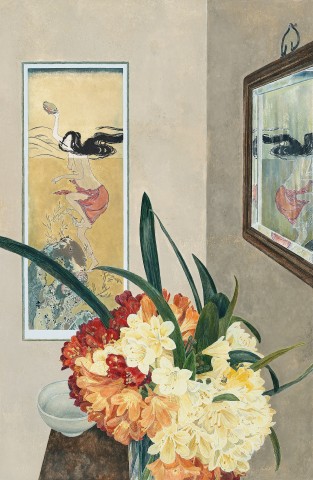JAPANESE PRINT AND CLIVIAS, 2013
CRESSIDA CAMPBELL
unique colour woodblock print
145.5 x 94.5 cm
signed below image lower right: Cressida Campbell
Philip Bacon Galleries, Brisbane (label attached verso)
Private collection, Brisbane, acquired from the above in 2013
Japanese Print and Clivias, 2013, watercolour on plywood, 146.0 x 96 cm, private collection, illus. in Cressida Campbell, Hamilton Art Gallery, Victoria, 11 May – 7 July 2019 (exhibition catalogue cover)
Cressida Campbell is an artist who requires no introduction, having attained through years of fastidious and unwavering commitment, a level of undeniable public and critical recognition. Dedicated to a labour intensive and intricate medium, Campbell’s artistic output is slow-paced, resulting in high demand for her hand painted prints and woodblocks alike. This large woodblock print, Japanese Print and Clivias from 2013, with its meticulous reflected composition, demonstrates the artist’s masterful handling of design, texture and tone. Through a delicate orchestration of the grooves and furrows of an incised plywood block, and the chalky deposits of watercolour left on its surface, Campbell conjures an image whose prosaic subject matter conceals the daring risks the artist has taken in its design. Japanese Print and Clivias is a work with a distinct Japanese aesthetic, with gentle attention to the flowers in the foreground balanced by significant areas of negative space.
At East Sydney Technical College, Cressida Campbell discovered and developed a strong affinity with the medium of woodblock printing. But it was in 1980, at the Yoshida Hanga Academy in Tokyo, Japan, that she found and adapted a technique of monoprinting from hand painted woodblocks, called Yiban Duose (meaning ‘one block, many colour printing’) into her own dominant pictorial mode. Since the late 1980s, Campbell has exhibited and sold each painted woodblock alongside its unique print. This unusual technique requires her compositions to work harmoniously in both positive and negative. The central subject matter of Japanese Print and Clivias, the eponymous Ukiyo-e print, its reflection and iridescent refractions in a bevelled mirror, provides a challenging compositional feat for Campbell. The artistic conceit of playing with reflections in a medium that is inherently based on printed mirror images shows both Campbell’s technical prowess and sense of humour.
An old-fashioned aesthete and collector, Campbell has filled her homes with a small treasure trove of textiles and bunches of cut flowers amongst artworks and objets d’art, ‘rare pieces and mere curiosities, but everything has been chosen for pleasure, not monetary value’.1 Many of the objects in the artist’s home and reproduced in her pictures carry stories about the artist’s life and her relationships, providing motifs that are carried throughout her oeuvre. The Japanese print referred to in the title of this artwork is in fact a silkscreen copy of a rare Ukiyo-e print of a Japanese abalone diver.2 This facsimile was created by John Coburn’s daughter, Kristin, for Campbell’s old friend, the artist Martin Sharp, who had owned and then lost the rare print in the 1980s. In contrast to the cossetted courtesans and geishas of other Ukiyo-e prints, the ama abalone divers were women liberated from societal expectations. In Japanese Print and Clivias, the diver inhabits many planes, travelling between the underwater world, the surface and another, more surreal plane in the mirrored surface, her hair flowing in invisible currents.
Campbell has used her immediate surroundings as subject matter for her artworks from the very earliest years of her practice. Building on the comfort of intimate and familiar subjects, she presents an aura of careful casualness that is both soothing and captivating. As John McDonald wrote, to qualify Campbell as a decorator is no insult, as ‘she is a decorator in the same manner as Matisse or Bonnard … in bringing us back to simple things, Campbell is exploring a decorative art for our times … the vital difference is that her prints almost radiate with the pleasure of their own making’.3
1. McDonald, J., ‘Cressida Campbell: Who wants the world?’, Sydney Morning Herald, 20 October 2017
2. The attribution of the original artwork is disputed. While some scholars believe that this artwork was created by the master Hokusai, others relate it to Kitagawa Utamaro’s Awabi-Tori suites from c.1788-1790
3.McDonald, J., ‘The Woodblock Painting of Cressida Campbell’, in Crayford, P. (ed.), The Woodblock Painting of Cressida Campbell, Public Pictures, Sydney, 2008, pp. 17 – 19
LUCIE REEVES-SMITH
